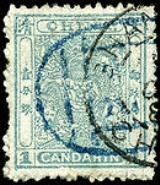
Postage stamps and postal history of China
Encyclopedia
The history of the postage stamp
s and postal history
of China
is complicated by the gradual decay of Imperial China and the years of civil war and Japan
ese occupation in the 1930s and 1940s.
in the 1st millennium BC
. During the Yuan Dynasty
under Kublai Khan
in the 12th century, China was integrated into the much larger Mongolian Örtöö
system. Marco Polo
reported that there were 10,000 post stages during that time. In addition, private letters were carried by the Min Hsin Chu, a system of letter guilds (hongs). Later the 1727 Treaty of Kyakhta with Russia
provided for the first regular exchange of mail.
A policy of isolation was forcibly ended in the 19th century by the Opium War and the subsequent opening of treaty ports; several nations opened foreign post offices from 1844 on. This expanded to involve dozens of cities, mostly on the coast, along the Yangtze River
, and in the far south. Shanghai
organized its own Shanghai local post in 1865. In the same year, the Englishman Robert Hart developed a mail service for the Imperial Maritime Customs, initially to carry consular mail to and from treaty ports. This service was opened to the public on 1 May 1878, and China's first postage stamps, the "Large Dragons" (大龍郵票), were issued to handle payment. The stamps were inscribed "CHINA" in both Latin and Chinese characters, and denominated in candareen
s.
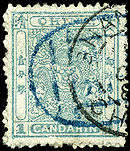 Initially, all mail to foreign destinations went through Shanghai, but by 1882 there were twelve post offices. On 20 March 1896, an edict directed that the Customs Post become the Imperial Postal Service effective 1 January 1897; the Min Hsin Chu was shut down, as well as the Shanghai local post, and postal system adopted cents and dollars as the units of currency.
Initially, all mail to foreign destinations went through Shanghai, but by 1882 there were twelve post offices. On 20 March 1896, an edict directed that the Customs Post become the Imperial Postal Service effective 1 January 1897; the Min Hsin Chu was shut down, as well as the Shanghai local post, and postal system adopted cents and dollars as the units of currency.
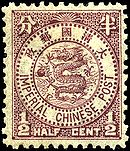 Through the first half of 1897, new stamps were unavailable, and so the existing stock was surcharge
Through the first half of 1897, new stamps were unavailable, and so the existing stock was surcharge
d in cents, with several variants distinguished by philatelists. Revenue stamp
s were surcharged as well.
The first new stamps, inscribed "IMPERIAL CHINESE POST" went on sale 16 August 1897. The twelve values, ranging from 1/2c to $5, were lithographed
in Japan
. The low values depicted a dragon
, the middle values a carp
, and the dollar values a wild goose
. This paper
used for these stamps had a watermark
in the form of a yin-yang symbol.
 In 1898, these were superseded by similar designs produced by engraving
In 1898, these were superseded by similar designs produced by engraving
in London
, and inscribed "CHINESE IMPERIAL POST" on a Chinese supplied watermarked paper of varying thickness. The watermark can be difficult to detect on the thicker paper. New printings of the stamp, beginning in 1899 were on unwatermarked paper, but there are no recorded usages of this variety until 1901. These stamps continued in use until the end of the empire. During that time some colours were changed to comply with Universal Postal Union regulations, and three new values were added.
The first commemorative stamp
s of China were issued in 1909 to mark the 1st year of the reign of the Xuantong Emperor. The set of three (2c, 3c, 7c), all depicted the Temple of Heaven
in Beijing
.
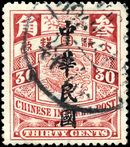 The revolution of 1911 resulted in overprints on the imperial stamps in 1912; at Foochow to indicate that the post office was effectively a neutral area available to both sides, and at Nanking and Shanghai
The revolution of 1911 resulted in overprints on the imperial stamps in 1912; at Foochow to indicate that the post office was effectively a neutral area available to both sides, and at Nanking and Shanghai
reading "Republic of China". An additional set of overprints were produced by Waterlow and Sons
in London, and postmasters throughout the country made their own unofficial overprints using the same characters.
The first new designs of the Republic were two commemorative sets of 12 each, the first set depicting Sun Yat-sen
and second Yuan Shikai
, both issued on 14 December 1912.
 The definitives of the "Junk issue" went on sale 5 May 1913, and continued in use into the 1930s. The low values featured a junk
The definitives of the "Junk issue" went on sale 5 May 1913, and continued in use into the 1930s. The low values featured a junk
, while values from 15c to 50c showed a farmer reaping rice, while the dollar values depicted the three-part gateway to the Hall of Classics in Beijing
. The series was first printed in London, then in Beijing from 1915; they can be distinguished by close examination. The designs were re-engraved in 1923, and a number of design features were changed; for instance, the whitecaps in the water underneath the junk were removed, and the water darkened.
marked his assumption of that role. On 1929-04-18 Chiang Kai-shek
makes a first appearance, commemorating the unification of China. Finally on 1929-05-30, two days before the event, four stamps showing Sun Yat Sen's mausoleum were issued to commemorate his state funeral.
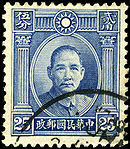
, would see much overprinting in the next several years. 1931 also saw the invasion of Manchuria
by the Japanese and the formation of Manchukuo
, which issued its own stamps.
Communist authorities issued stamps in areas over which they had control from 1930 onwards. These were usually in more remote areas, often on the mountainous borders of two provinces - hence they are often referred to as 'Border Areas'. For example, the earliest communist issues (the so called 'Red Posts') were in mountainous areas of Jiangxi
, the Hunan
- Hubei
border area and West Fujian
, bordering Jiangxi.
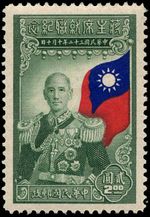
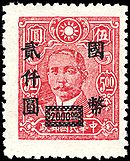
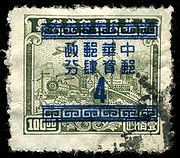
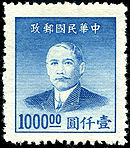 The end of the conflict brought little respite to the Nationalist government, which continued to struggle with Communist forces. But they were able to issue commemoratives to remember President Lin Sen
The end of the conflict brought little respite to the Nationalist government, which continued to struggle with Communist forces. But they were able to issue commemoratives to remember President Lin Sen
, who had died in 1943, to mark the October inauguration of Chiang, and to celebrate the Allied victory.
Inflation had been creating a need for ever-higher values throughout 1945, but in 1946 things went out of control; stocks of stamps, some dating back to 1931, were surcharged with values up to $2000, and a new design (still featuring a portrait of Sun Yat-sen
) went up to $5000.
1947 saw a number of commemorative issues, and further inflation, a Sun Yat-sen with plum
blossoms issue reaching $50,000 that year, then surpassed in 1948 with reissues topping out with a $5,000,000 stamp.
In 1948, a gold yuan standard was adopted, and an assortment of existing stamps were surcharged with values from 1/2c and up. This was a short-lived stopgap, and by early 1949 it became necessary to stamps and overprints with a range of values, again going up to $5,000,000.
On 1 May 1949, the government took a desperate step, which was to print undenominated stamps, sold at the daily rate of the yuan. They then adopted a silver yuan standard, and overprinted still more stamps as well as reissuing the Sun Yat-sen design valued in 1-500 cents. By August, the deteriorating political situation had caught up with the postal system, and the Nationalists' last issues on the mainland were two of a planned series of pictorial designs denominated in silver yuan.
Postage stamp
A postage stamp is a small piece of paper that is purchased and displayed on an item of mail as evidence of payment of postage. Typically, stamps are made from special paper, with a national designation and denomination on the face, and a gum adhesive on the reverse side...
s and postal history
Postal history
Postal history is the study of postal systems and how they operate and, or, the study of postage stamps and covers and associated material illustrating historical episodes of postal systems...
of China
China
Chinese civilization may refer to:* China for more general discussion of the country.* Chinese culture* Greater China, the transnational community of ethnic Chinese.* History of China* Sinosphere, the area historically affected by Chinese culture...
is complicated by the gradual decay of Imperial China and the years of civil war and Japan
Japan
Japan is an island nation in East Asia. Located in the Pacific Ocean, it lies to the east of the Sea of Japan, China, North Korea, South Korea and Russia, stretching from the Sea of Okhotsk in the north to the East China Sea and Taiwan in the south...
ese occupation in the 1930s and 1940s.
Imperial China
Regular government postal service is known from the Zhou DynastyZhou Dynasty
The Zhou Dynasty was a Chinese dynasty that followed the Shang Dynasty and preceded the Qin Dynasty. Although the Zhou Dynasty lasted longer than any other dynasty in Chinese history, the actual political and military control of China by the Ji family lasted only until 771 BC, a period known as...
in the 1st millennium BC
1st millennium BC
The 1st millennium BC encompasses the Iron Age and sees the rise of many successive empires, and spanned from 1000 BC to 1 BC.The Neo-Assyrian Empire, followed by the Achaemenids. In Greece, Classical Antiquity begins with the colonization of Magna Graecia and peaks with the rise of Hellenism. The...
. During the Yuan Dynasty
Yuan Dynasty
The Yuan Dynasty , or Great Yuan Empire was a ruling dynasty founded by the Mongol leader Kublai Khan, who ruled most of present-day China, all of modern Mongolia and its surrounding areas, lasting officially from 1271 to 1368. It is considered both as a division of the Mongol Empire and as an...
under Kublai Khan
Kublai Khan
Kublai Khan , born Kublai and also known by the temple name Shizu , was the fifth Great Khan of the Mongol Empire from 1260 to 1294 and the founder of the Yuan Dynasty in China...
in the 12th century, China was integrated into the much larger Mongolian Örtöö
Yam (route)
Yam is a supply point route messenger system employed and extensively used and expanded by Genghis Khan and used by subsequent Great Khans and Khans.Relay stations were used to give food, shelter and spare horses for Mongol armies messengers...
system. Marco Polo
Marco Polo
Marco Polo was a Venetian merchant traveler from the Venetian Republic whose travels are recorded in Il Milione, a book which did much to introduce Europeans to Central Asia and China. He learned about trading whilst his father and uncle, Niccolò and Maffeo, travelled through Asia and apparently...
reported that there were 10,000 post stages during that time. In addition, private letters were carried by the Min Hsin Chu, a system of letter guilds (hongs). Later the 1727 Treaty of Kyakhta with Russia
Russia
Russia or , officially known as both Russia and the Russian Federation , is a country in northern Eurasia. It is a federal semi-presidential republic, comprising 83 federal subjects...
provided for the first regular exchange of mail.
A policy of isolation was forcibly ended in the 19th century by the Opium War and the subsequent opening of treaty ports; several nations opened foreign post offices from 1844 on. This expanded to involve dozens of cities, mostly on the coast, along the Yangtze River
Yangtze River
The Yangtze, Yangzi or Cháng Jiāng is the longest river in Asia, and the third-longest in the world. It flows for from the glaciers on the Tibetan Plateau in Qinghai eastward across southwest, central and eastern China before emptying into the East China Sea at Shanghai. It is also one of the...
, and in the far south. Shanghai
Shanghai
Shanghai is the largest city by population in China and the largest city proper in the world. It is one of the four province-level municipalities in the People's Republic of China, with a total population of over 23 million as of 2010...
organized its own Shanghai local post in 1865. In the same year, the Englishman Robert Hart developed a mail service for the Imperial Maritime Customs, initially to carry consular mail to and from treaty ports. This service was opened to the public on 1 May 1878, and China's first postage stamps, the "Large Dragons" (大龍郵票), were issued to handle payment. The stamps were inscribed "CHINA" in both Latin and Chinese characters, and denominated in candareen
Candareen
A candareen is a traditional measurement of weight in East Asia. It is equal to 10 cash and is 1/10 of a mace. It is approximately 378 milligrams. A troy candareen is approximately 374 milligrams....
s.


Overprint
An overprint is an additional layer of text or graphics added to the face of a postage stamp or banknote after it has been printed. Post offices most often use overprints for internal administrative purposes such as accounting but they are also employed in public mail...
d in cents, with several variants distinguished by philatelists. Revenue stamp
Revenue stamp
A revenue stamp, tax stamp or fiscal stamp is a adhesive label used to collect taxes or fees on documents, tobacco, alcoholic drinks, drugs and medicines, playing cards, hunting licenses, firearm registration, and many other things...
s were surcharged as well.
The first new stamps, inscribed "IMPERIAL CHINESE POST" went on sale 16 August 1897. The twelve values, ranging from 1/2c to $5, were lithographed
Lithography
Lithography is a method for printing using a stone or a metal plate with a completely smooth surface...
in Japan
Japan
Japan is an island nation in East Asia. Located in the Pacific Ocean, it lies to the east of the Sea of Japan, China, North Korea, South Korea and Russia, stretching from the Sea of Okhotsk in the north to the East China Sea and Taiwan in the south...
. The low values depicted a dragon
Dragon
A dragon is a legendary creature, typically with serpentine or reptilian traits, that feature in the myths of many cultures. There are two distinct cultural traditions of dragons: the European dragon, derived from European folk traditions and ultimately related to Greek and Middle Eastern...
, the middle values a carp
Carp
Carp are various species of oily freshwater fish of the family Cyprinidae, a very large group of fish native to Europe and Asia. The cypriniformes are traditionally grouped with the Characiformes, Siluriformes and Gymnotiformes to create the superorder Ostariophysi, since these groups have certain...
, and the dollar values a wild goose
Goose
The word goose is the English name for a group of waterfowl, belonging to the family Anatidae. This family also includes swans, most of which are larger than true geese, and ducks, which are smaller....
. This paper
Postage stamp paper
Postage stamp paper is the foundation or substrate of the postage stamp to which the ink for the stamp's design is applied to one side and the adhesive is applied to the other...
used for these stamps had a watermark
Watermark
A watermark is a recognizable image or pattern in paper that appears as various shades of lightness/darkness when viewed by transmitted light , caused by thickness or density variations in the paper...
in the form of a yin-yang symbol.

Engraving
Engraving is the practice of incising a design on to a hard, usually flat surface, by cutting grooves into it. The result may be a decorated object in itself, as when silver, gold, steel, or glass are engraved, or may provide an intaglio printing plate, of copper or another metal, for printing...
in London
London
London is the capital city of :England and the :United Kingdom, the largest metropolitan area in the United Kingdom, and the largest urban zone in the European Union by most measures. Located on the River Thames, London has been a major settlement for two millennia, its history going back to its...
, and inscribed "CHINESE IMPERIAL POST" on a Chinese supplied watermarked paper of varying thickness. The watermark can be difficult to detect on the thicker paper. New printings of the stamp, beginning in 1899 were on unwatermarked paper, but there are no recorded usages of this variety until 1901. These stamps continued in use until the end of the empire. During that time some colours were changed to comply with Universal Postal Union regulations, and three new values were added.
The first commemorative stamp
Commemorative stamp
A commemorative stamp is a postage stamp, often issued on a significant date such as an anniversary, to honor or commemorate a place, event or person. The subject of the commemorative stamp is usually spelled out in print, unlike definitive stamps which normally depict the subject along with the...
s of China were issued in 1909 to mark the 1st year of the reign of the Xuantong Emperor. The set of three (2c, 3c, 7c), all depicted the Temple of Heaven
Temple of Heaven
The Temple of Heaven, literally the Altar of Heaven is a complex of Taoist buildings situated in the southeastern part of central Beijing. The complex was visited by the Emperors of the Ming and Qing dynasties for annual ceremonies of prayer to Heaven for good harvest...
in Beijing
Beijing
Beijing , also known as Peking , is the capital of the People's Republic of China and one of the most populous cities in the world, with a population of 19,612,368 as of 2010. The city is the country's political, cultural, and educational center, and home to the headquarters for most of China's...
.
The 1910s

Shanghai
Shanghai is the largest city by population in China and the largest city proper in the world. It is one of the four province-level municipalities in the People's Republic of China, with a total population of over 23 million as of 2010...
reading "Republic of China". An additional set of overprints were produced by Waterlow and Sons
Waterlow and Sons
The Waterlow and Sons Limited was a major worldwide engraver of currency, postage stamps, stocks and bond certificates established in 1897, in England.-Portuguese Bank Note Crisis:...
in London, and postmasters throughout the country made their own unofficial overprints using the same characters.
The first new designs of the Republic were two commemorative sets of 12 each, the first set depicting Sun Yat-sen
Sun Yat-sen
Sun Yat-sen was a Chinese doctor, revolutionary and political leader. As the foremost pioneer of Nationalist China, Sun is frequently referred to as the "Father of the Nation" , a view agreed upon by both the People's Republic of China and the Republic of China...
and second Yuan Shikai
Yuan Shikai
Yuan Shikai was an important Chinese general and politician famous for his influence during the late Qing Dynasty, his role in the events leading up to the abdication of the last Qing Emperor of China, his autocratic rule as the second President of the Republic of China , and his short-lived...
, both issued on 14 December 1912.

Junk (ship)
A junk is an ancient Chinese sailing vessel design still in use today. Junks were developed during the Han Dynasty and were used as sea-going vessels as early as the 2nd century AD. They evolved in the later dynasties, and were used throughout Asia for extensive ocean voyages...
, while values from 15c to 50c showed a farmer reaping rice, while the dollar values depicted the three-part gateway to the Hall of Classics in Beijing
Beijing
Beijing , also known as Peking , is the capital of the People's Republic of China and one of the most populous cities in the world, with a population of 19,612,368 as of 2010. The city is the country's political, cultural, and educational center, and home to the headquarters for most of China's...
. The series was first printed in London, then in Beijing from 1915; they can be distinguished by close examination. The designs were re-engraved in 1923, and a number of design features were changed; for instance, the whitecaps in the water underneath the junk were removed, and the water darkened.
The 1920s
China produced five new commemorative issues, of four stamps each, during the 1920s. The first, issued on 1921-10-10 to commemorate the 25th anniversary of the Chinese Post Office featured then president Xu Shichang in the centre, flanked by Premier Jing Yongbeng and Minister of Communication Ye Gongzuo. On 1923-10-17 a set showing the Temple of Heaven commemorated the new constitution. On 1928-03-01 a set depicting Marshal of the Army and Navy Zhang ZuolinZhang Zuolin
Zhang Zuolin was the warlord of Manchuria from 1916 to 1928 . He successfully invaded China proper in October 1924 in the Second Zhili-Fengtian War. He gained control of Peking, including China's internationally recognized government, in April 1926...
marked his assumption of that role. On 1929-04-18 Chiang Kai-shek
Chiang Kai-shek
Chiang Kai-shek was a political and military leader of 20th century China. He is known as Jiǎng Jièshí or Jiǎng Zhōngzhèng in Mandarin....
makes a first appearance, commemorating the unification of China. Finally on 1929-05-30, two days before the event, four stamps showing Sun Yat Sen's mausoleum were issued to commemorate his state funeral.

The 1930s
New definitives in 1931 depicted Sun Yat-sen. These stamps, along with the Martyrs issue of 1932 honoring six martyrs of the KuomintangKuomintang
The Kuomintang of China , sometimes romanized as Guomindang via the Pinyin transcription system or GMD for short, and translated as the Chinese Nationalist Party is a founding and ruling political party of the Republic of China . Its guiding ideology is the Three Principles of the People, espoused...
, would see much overprinting in the next several years. 1931 also saw the invasion of Manchuria
Manchuria
Manchuria is a historical name given to a large geographic region in northeast Asia. Depending on the definition of its extent, Manchuria usually falls entirely within the People's Republic of China, or is sometimes divided between China and Russia. The region is commonly referred to as Northeast...
by the Japanese and the formation of Manchukuo
Manchukuo
Manchukuo or Manshū-koku was a puppet state in Manchuria and eastern Inner Mongolia, governed under a form of constitutional monarchy. The region was the historical homeland of the Manchus, who founded the Qing Empire in China...
, which issued its own stamps.
Communist authorities issued stamps in areas over which they had control from 1930 onwards. These were usually in more remote areas, often on the mountainous borders of two provinces - hence they are often referred to as 'Border Areas'. For example, the earliest communist issues (the so called 'Red Posts') were in mountainous areas of Jiangxi
Jiangxi
' is a southern province in the People's Republic of China. Spanning from the banks of the Yangtze River in the north into hillier areas in the south, it shares a border with Anhui to the north, Zhejiang to the northeast, Fujian to the east, Guangdong to the south, Hunan to the west, and Hubei to...
, the Hunan
Hunan
' is a province of South-Central China, located to the south of the middle reaches of the Yangtze River and south of Lake Dongting...
- Hubei
Hubei
' Hupeh) is a province in Central China. The name of the province means "north of the lake", referring to its position north of Lake Dongting...
border area and West Fujian
Fujian
' , formerly romanised as Fukien or Huguing or Foukien, is a province on the southeast coast of mainland China. Fujian is bordered by Zhejiang to the north, Jiangxi to the west, and Guangdong to the south. Taiwan lies to the east, across the Taiwan Strait...
, bordering Jiangxi.
Postwar




Lin Sen
Lin Sen , courtesy name Zichao , sobriquet Changren , was President of the National Government of the Republic of China from 1931 until his death.-Early life:...
, who had died in 1943, to mark the October inauguration of Chiang, and to celebrate the Allied victory.
Inflation had been creating a need for ever-higher values throughout 1945, but in 1946 things went out of control; stocks of stamps, some dating back to 1931, were surcharged with values up to $2000, and a new design (still featuring a portrait of Sun Yat-sen
Sun Yat-sen
Sun Yat-sen was a Chinese doctor, revolutionary and political leader. As the foremost pioneer of Nationalist China, Sun is frequently referred to as the "Father of the Nation" , a view agreed upon by both the People's Republic of China and the Republic of China...
) went up to $5000.
1947 saw a number of commemorative issues, and further inflation, a Sun Yat-sen with plum
Plum
A plum or gage is a stone fruit tree in the genus Prunus, subgenus Prunus. The subgenus is distinguished from other subgenera in the shoots having a terminal bud and solitary side buds , the flowers in groups of one to five together on short stems, and the fruit having a groove running down one...
blossoms issue reaching $50,000 that year, then surpassed in 1948 with reissues topping out with a $5,000,000 stamp.
In 1948, a gold yuan standard was adopted, and an assortment of existing stamps were surcharged with values from 1/2c and up. This was a short-lived stopgap, and by early 1949 it became necessary to stamps and overprints with a range of values, again going up to $5,000,000.
On 1 May 1949, the government took a desperate step, which was to print undenominated stamps, sold at the daily rate of the yuan. They then adopted a silver yuan standard, and overprinted still more stamps as well as reissuing the Sun Yat-sen design valued in 1-500 cents. By August, the deteriorating political situation had caught up with the postal system, and the Nationalists' last issues on the mainland were two of a planned series of pictorial designs denominated in silver yuan.
Division
Philatelists conventionally split into two separate topics at this point:- Postage stamps and postal history of the Republic of China (first stamps 1912)
- Postage stamps and postal history of the People's Republic of ChinaPostage stamps and postal history of the People's Republic of ChinaAlthough postal service in China goes back some 2,500 years, modern postal services were not established until 1877 by the Qing government. The postal system of the People's Republic of China was established as the General Postal Administration in Beijing in 1949, growing out of the posts that had...
(first stamps 8 October 1949)
See also
- China Philatelic Society of LondonChina Philatelic Society of LondonThe China Philatelic Society of London is a philatelic organisation devoted to the study of all aspects of Chinese philately from the Municipal Posts of the Treaty Ports to the People's Republic and Taiwan.-Origins:...
- China Stamp SocietyChina Stamp SocietyThe China Stamp Society is a philatelic organization dedicated to the appreciation of the postage stamps and postal history of China, including the Treaty Ports, Foreign Offices in China, the Japanese Occupation, Hong Kong, Macao, Manchukuo and Tibet....
- Chinese Golden Monkey stampChinese Golden Monkey stampThe Chinese Golden Monkey Stamp was a postage stamp issued in China in 1980 of which 5 million copies were printed and which therefore cannot be regarded as rare but which has come to symbolise the strong market for collectable postage stamps in Asia...
- Chinese Postal Map Romanization
- Postage stamps and postal history of the People's Republic of ChinaPostage stamps and postal history of the People's Republic of ChinaAlthough postal service in China goes back some 2,500 years, modern postal services were not established until 1877 by the Qing government. The postal system of the People's Republic of China was established as the General Postal Administration in Beijing in 1949, growing out of the posts that had...
- Postage stamps and postal history of Hong KongPostage stamps and postal history of Hong KongHong Kong formerly produced postage stamps with the name Hong Kong, with the face of the reigning monarchs of the United Kingdom, or with the royal symbols . After the Hong Kong's transfer of sovereignty to China, stamps are now issued with the name Hong Kong, China...
- Postage stamps and postal history of MacauPostage stamps and postal history of Macau-Early colonial history:The first stamps issued for Macau, appearing in 1884, used the common "Portuguese crown" design for nine values ranging from 5 to 300 reis. Later in 1884, an 80-reis value was produced as a surcharge on the 100-reis value; in 1885 an 80-reis value of the crown design went on...
- Sun Yat-sen stampsSun Yat-sen stampsNumerous Chinese stamps depict Sun Yat-sen, and a representative collection can be acquired with little trouble. These may conveniently be divided as the definitives, provincial issues, overprints, and commemoratives, but there is much crossover between these categories.-Definitives:The material...
Sources
- Stanley Gibbons Ltd: various catalogues
- Encyclopaedia of Postal History
- Stuart Rossiter & John Flower: The Stamp Atlas

